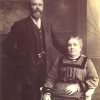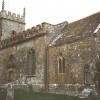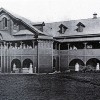Although beginning his working life as a house decorator, John Pouncy became a pioneer in the development of photography, a creative but somewhat immodest genius who had to contend with rivalry over the inventor-ship of the process he was convinced he could rightly lay claim to. He also had a sympathetic and philanthropic side to his character that was once put to good use when he lent nursing assistance at the local hospital during an epidemic of cholera. John Pouncy’s was a fascinating and innovative nature, at first somewhat restrained in the full potential of its expression by his first mundane occupation, but the course of his life was first to take a drastic turn.
Pouncy was born in Dorchester on July 16th 1818, the son of William Pouncy, a Piddletrenthide labourer and his wife Mary. In 1843 he married Mary Ann Sprackley, the mother of his first child Walter, though she died in 1846. Just four years later Pouncy met and married Mary Catherine Wills, who presented him with another son and four daughters who all apparently died young or before reaching adulthood.
Until 1854 Pouncy was painting and decorating houses, glazing windows, gilding and carving, but then the new science of photography so gripped his imagination that he resolved to dedicate the rest of his life to it. From then on, and for the next four years, he had to support his new occupation with the earnings from his first one. As late as 1859 the Dorset County Chronicle carried a report “…Mr Pouncy’s proper profession is that of a house painter.” Three years earlier Pouncy announced through the Chronicle that he intended to publish a photo-illustrated gazetteer of Dorset featuring pictures captioned with historic commentaries.
But John Pouncy had another aim: to resolve through experimentation a major drawback of early photography: that of fading. At the time photographic prints were produced by the salts of silver process, an emulsion notoriously susceptible to fading, and which would hinder Pouncy’s intention to produce permanent visual records of Dorset. To circumvent the shortcoming, Pouncy resorted to photo-lithography, itself a still very imperfect process. Yet Pouncy’s attempt to unite lithography with photography met with some success with the publication in 1857 of his book “Dorsetshire Photographically Illustrated” – the first English publication ever to feature photo litho-graphic illustrations.
Dorset Photographically Illustrated is a remarkable achievement for the time. It is original in technique and so not at all what would be expected from one who semi-abandoned the painting and decorating trade for a discipline in which he had no prior training. The book features 80 illustrations, each with two or more pages of historical narrative and 200 double-panel 8” x 11” pages. The text is peppered with erudite classical quotations from nature poets such as Cowper, Thomson and Wordsworth, and the writing is that of one trying to impress the reader with his learning. What comes across is the mind of an intelligent, practical autodidact who clearly shows an overriding preoccupation with landscapes. Indeed, Pouncy was only concerned with photography for professional reasons; he nurtured no desire to undertake commissioned work for illustrating the publications of others.
Despite the success of the book Pouncy was sufficiently dissatisfied with the quality of the prints to attempt further improvement through experimentation. Spurned on by the offer of an award from the Photographic Society of London to anyone who could solve the problem of fading. Pouncy worked on a process, the basic principle of which had been discovered by Mungo Ponton in 1839. Ponton had noticed that paper coated with potassium bichromate became photo-reactive. Pouncy then coated paper with bichromate, but added gum Arabic and vegetable carbon to it. Having reported his results to the Photographic society in 1858, Pouncy then patented his process. He then continued to perfect the process over the next four or five years, and in 1863 he took out another patent, though acrimony was following not far behind as the question of who had truly been the inventor of carbon printing arose.
Pouncy did however receive some recognition for his pains from Thomas Sutton, editor of the journal “Photographic Notes,” and in 1859 he was finally awarded the French silver Duc de Luynes Medal. It is probable that John Pouncy did have a legitimate claim as the inventor of carbon printing, and he himself certainly thought so, even believing that he could rightly lay claim to the gold Duc de Luynes medal, awarded to a French rival, Alphonse Poitevin eight years later.
Besides the Duc de Luynes prize Pouncy was awarded medals from Scotland (1863), Prussia (1865) and Edinburgh (1867); furthermore his studio received patronage from the Prince Consort, Albert, and the Prince of Wales. It is widely suspected that a photograph of Thomas Hardy as a boy of 16 in the author’s archive was taken by Pouncy – not by any means the sole connection between the two men, as will presently be noted.
But the dispute over rival claims of inventor-ship and bickering within the profession that Pouncy experienced, diminished his ardour for the new art soon after the 1863 patent was granted. Throughout the 1860’s he was still ‘moonlighting’ as a decorator, but the premature deaths of his sons by his second wife left Pouncy with only Walter to inherit his photography business. And in September 1872 the transition from father to son was done and dusted.
What Hardy did in writing to exteriorise Dorset, Pouncy did likewise in his photographs. And it is through this common life-mission that the two men’s paths inevitably converged. Consequently there exist several firm pieces of evidence that Hardy knew of Pouncy’s work and book, even if the latter had never taken that teenage portrait of the famous writer. These points can be summarised as follows:
(1) In Hardy’s novel “A Laodicean,” the central character William Dare is a photographic inventor seemingly modelled directly upon John Pouncy. In his carrying about of camera, tripod and equipment, Dare appears to be doing precisely what Pouncy would have done in preparing for his book on Dorset.
(2) When compiling Dorsetshire, Pouncy was in consultation with the architect John Hicks over matters of style and restoration. At exactly this time (July 1856) Hardy became apprenticed to Hicks for his architectural training.
(3) In 1881 Hardy was contemplating producing a book of his own on Dorset, very much along the lines of Pouncy’s, though in collaboration with Henry Moule.
(4) Even more compelling evidence that Dorsetshire was known to Hardy comes from the book itself. In its description of Kingston House, Pouncy explains how the brick building came to be faced in Portland stone: “…on one occasion before the notion had even entered the worthy owner’s head that Portland stone might be used advantageously to veil the brick walls of his mansion he was conversing with his illustrious visitor about the house.. The King [George III] however, did nothing but utter the words “Brick Mr Pitt, Brick…..” Hardy appears to be reproducing the same incident in almost identical wording in “The Hand of Ethelbert:” “…to a stone mask worn by a brick face a story naturally appertained…one which has since done service in other quarters. When the vast addition [i.e. the modern manor house]…had just been completed, King George visited Enchworth. The owner pointed out the features of his grand architectural attempt and waited for commendation. “Brick, brick, brick, said the King…Thin freestone slabs were affixed to the whole series of fronts by copper cramps and dowels.”
John Pouncy died in March 1894, aged 75, after contracting a cold that developed into bronchitis. In its obituary the Dorset Chronicle & Somerset Gazette stated that he was a successful worker whose long study of his subject and its intricacies imparted much valuable information to the younger generation. Even in his last weeks of illness he was not content to stay indoors but would set out in the winter cold that probably hastened his untimely end.
Walter Pouncy, John Pouncy’s only surviving son and business heir, was born in Fordington in 1845. The 1891 census for Dorchester records that he married Eliza Rudduck, a Reading woman, at Leeds in December 1881, and lists his occupation as that of “Photographic Artist.” By the time of the census Walter would have had full control of his father’s business (thereafter renamed W. Pouncy’s Photographic Institution) for 19 years.
Walter seems not to have possessed either his father’s inventiveness or his flair for controversy; he therefore did not cut a noticeable dash in Dorchester society. Nevertheless he maintained and built upon John’s archive of Dorset landscapes over another four decades and, perhaps like his father, personally knew and took studio portraits of Hardy.
Pouncy also made slides for illustrated lectures given by Harry Pouncy, a distant relative and namesake, on the subject of Wessex. When in 1914 the Dorset County Chronicle published a large landscape panorama of Maiden Castle taken by Walter (his chef d’oeuvre) it credited him with being simply “the doyen of Dorchester photographers.” A large collection of his pictures is in the possession of the County Museum. Walter Pouncy died in 1918, exactly a century after the birth of his father.



